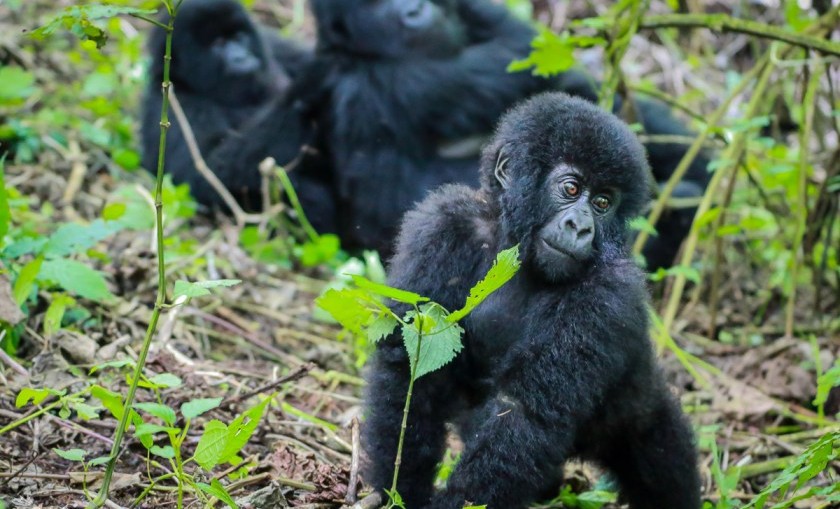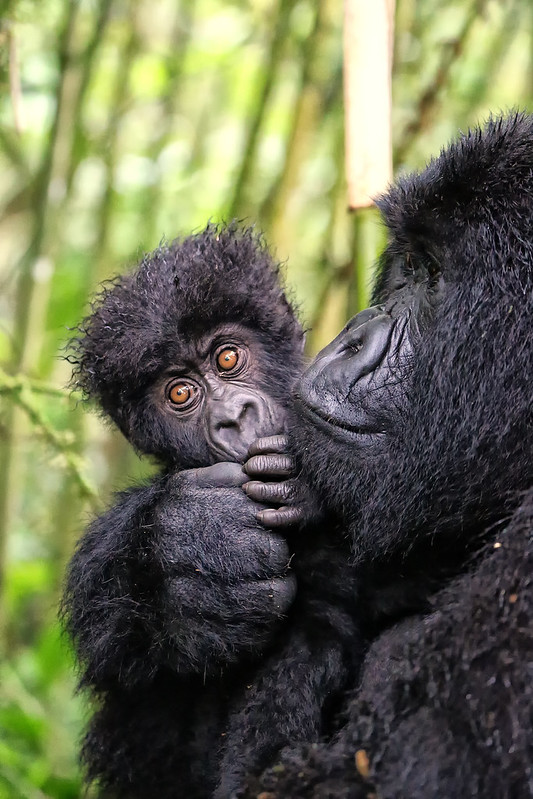
Trekking for mountain gorillas in Uganda, Rwanda and D.R.Congo is one of the most beautiful and fragile adventure experiences in Africa, owing to the fact that mountain gorillas are highly endangered species in need of protection, while tours to see these endangered rare species is actually what’s funding the gorilla conservation efforts and hence one needs the other for survival.
On this note, certain restrictions apply so as to meet conservation and protection goals of these critically endangered primates in the world. This lifetime adventure comes with numerous safety guidelines that must be observed while you are in the forest trekking to find your assigned gorilla family. Safety and conservation of these endangered apes in the wild is aided by the set regulations that every visitor is required to observe while on a face to face with these critically endangered species.

Around 1980’s, these rare species almost got wiped out as a result of uncontrolled human practices such as poaching, human infectious disease spread, civil wars, lack of government concern. Their protection then caught much attention at a time when Dian Fossey was conducting her research where she constructed the Karisoke Research Center on Mount Karisimbi along the Rwandan part of the Virunga Conservation area and dedicated her life towards protecting these critically endangered species whose number counts not more than 900 today. Given the protection efforts that Dian Fossey invested into these rare species, it is of no doubt that mountain gorilla safaris have featured among the very few most sought after adventures for most travelers in and around the globe. This has also helped in boosting their conservation in the wild as the income that is generated from the trekking permits are used to facilitate conservation programs in areas of research, medicines, paying staff, facilitating gorilla doctors and benefits the national economy.
In any of the 3 countries where mountain gorillas can be seen, all gorilla safaris start with an early morning briefing by the park official who takes visitors through dos and don’ts for gorilla trekking. After the briefing, you will be assigned to only one habituated group to track in a group of 8 (eight) people and one tour guide. If you are planning to go for this lifetime adventure, you should be physically well to hike through the thick jungles and steep slopes as you look out for these dramatic creatures in their natural habitat. To be on safer side, feel free to request for moderate families for you to track. You may also hire a porter at the park headquarters to assist you with heavy luggage. Also, never forget to take a walking stick along with you for support while hiking through muddy and slippery places.
Gorilla trekking is only limited to eight (8) visitors who are assigned to only one habituated family to track each day and only an hour is given to you to strike your imaginations with the gorillas, explore their behavior and take as many photos as you can. These apes are wild species and human presence means intruding into their home and thus a threat to their emotions which is why the number of trekkers is restricted to ensure that the spread of human infectious diseases is reduced. For visitors who wish to enhance their experiences with these primates, you can engage in Gorilla Habituation Experience which is only conducted in Bwindi Impenetrable Forest National Park and only four (4) visitors are allowed to track and visitors are accompanied by researchers and trackers. For this extraordinary adventure, trekkers are given only 4 hours to be with a group of the gorillas.
All gorilla destinations have a list of rules and regulations that visitors required to observe at all times while in the forest with the Great apes. While with gorillas, avoid eye contact at all times as this can make them get irritated or recharge against you, be submissive before gorillas, maintain a distance of 7 meters at all times from gorillas, in case of any illnesses do not go for gorilla trekking and if you have cough make sure that you cover the mouth while coughing. All these precautions are intended to safe guard mountain gorillas from the spread of any human infectious diseases.
Given that mountain gorillas share about 98% of their DNA with humans, making them to be very vulnerable to human diseases, it is advisable that you maintain a distance of seven meters at all times off from gorillas. You are therefore advised not to have any body contact with these endangered primates while in their natural habitat. If you are not feeling well, you are advised not to go for this experience and you can cancel it as earlier as possible and then make it another day.
While you might be tempted to eat while in the habitat, this behavior is not welcome if you are trekking these critically endangered apes. Keep your trash till you return to the park headquarters where there are containers or rubbish pits for you to dump your rubbish. You are also advised not to smoke, eat or drink while trekking these rare species in the forest. Always leave the habitat the gorilla habitat clean the way you found it or even beyond.
Dress And Pack Appropriately To Stay Safe From The Apes
If you are planning for this adventure, you are advised to dress up based on the nature of the environment meaning dull colors or nature like colors are the best and make sure that you avoid bright colors as much as you can. Most importantly, in your packing list, you will need to include items like waterproof hiking boots and these should be light weight and they should provide support to your ankles while you are walking, long sleeved shirts/T-shirts, rain jackets or poncho, long trousers, insect repellents to protect you from sticking insects, gardening gloves to safeguard your hands in case of any itching plants, first aid kit, energy giving snacks, water, camera and additional batteries and others.
In conclusion, the above listed tips are of significant value to you as you plan for your next vacation to Africa. They play a great role not in only making your vacation the most enjoyable but also impacts towards protection and conservation of the rare mountain gorillas and other wildlife species that thrive within the same habitat.
